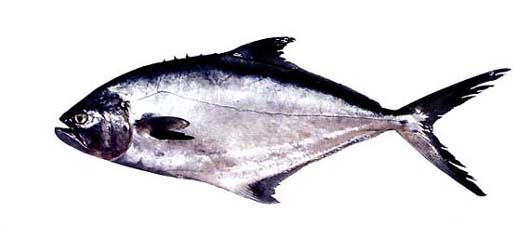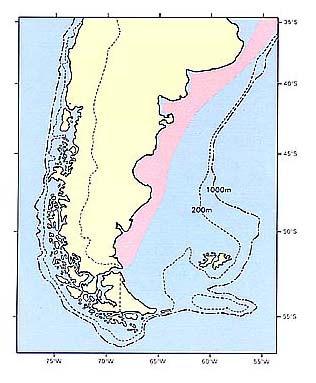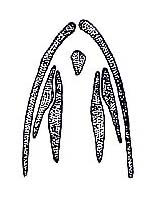アジ科
アジ科(Carangidae)

78 スジイケガツオ(Suzi-ikegatsuo)
Parona signata (Jenyns, 1842)
Palometa (Arg., Urg.); Pampo-do-alto (Br.)
特 徴:
背鰭5~6棘,34~37軟条,臀鰭1~2棘,33~41軟条,胸鰭17~21軟条,鰓耙数7~8+1+13~14=22~24,鰓条骨数8~9(ほとんど9),脊椎骨数10+17=27。頭長は体長の23.7-24.6%,眼径は2.8~3.7%,体高は38.5~40.9%,吻長は5.5~5.8%,両眼間隔は5.5~5.7%,上顎長は12.7~13.1%,尾柄高は6.0~6.5%,胸鰭長は14.4~14.7%,背鰭高は16.2~18.0%,臀鰭高は14.3~16.0%。体は大いに側扁し,体高は高い。頭部と眼は小さい。小円鱗が体側に密に分布するが,頭部は無鱗。両顎の小円錐歯は前方で数列,後方に行くにしたがって1列になる。鋤骨と口蓋骨に微小歯があるが,一見無歯のように見える。鰓耙は長く,その内側に細かい歯状突起が1列にならぶ。胸鰭は小さい。腹鰭はない。尾鰭は深く二叉する。背鰭と臀鰭の基底は長く,両者はほぼ対在する。側線は鰓蓋上縁上に発し不規則に屈曲しながら胸鰭上方を上昇し,ついで下降し尾鰭基底まで直走する。側線は前方で約7~8本の分枝を上方に出す。体色は背側が青味がかった濃褐色。体側と腹側は銀白色。背鰭は濃褐色。胸鰭と尾鰭は褐色。臀鰭はやや褐色をおびた銀白色。胸鰭の下方の体側上にあざやかな黒斑がある。体長60cmに達する。白身で肉質は堅くて良好。アルゼンチンでは賞味される。
分 布:
ブラジル南部からアルゼンチンにかけての陸棚上に分布。
備 考:
本種は1属1種で大西洋にしか産しないが,日本近海のイケガツオ類(Scomberoides)に近縁と考えられている(Smith-Vaniz and Staiger, 1973)。アルゼンチン近海の資源量は8,400tと推定され,年間適正漁獲量は1,600tと考えられている(Bellisio, Lópes and Torno, 1979)。
(中村 泉)
Material examined:
10 from Argentina (339.6-391.5 mm SL), FAKU 42948, 42978, 42979, 43442, 43443; AP 318, 327-330.
Description:
D Ⅴ-Ⅵ, 34-37; A Ⅰ-Ⅱ, 33-41; P1 17-21; GR 7-8+1+13-14=22-24; BR 8-9 (mostly 9); Ⅴ 10+17=27. HL 23.7-24.6% of SL; ED 2.8-3.7; BD 38.5-40.9; SN 5.5-5.8; IO 5.5-5.7; UJ 12.7-13.1; CP 6.0-6.5; P1 14.4-14.7; DH 16.2-18.0; AH 14.3-16.0.
Body deep, extremely compressed, body depth 2.2-2.5 times in SL. Head small, 4.1-4.3 times in SL. Eye small, 7.5-8.5 times in SL. Snout short, about half of postorbital length. Mouth large, oblique, posterior end of upper jaw extending slightly posterior to posterior margin of eye. Posterior part of maxilla flat, wide, round. Bands of villiform teeth in both jaws, tapering to nearly a single series posteriorly. Fine microscopically visible teeth on vomer and palatines. Long and slender gill-rakers with fine inner serrations on first gill-arch. Pseudobranchiae present. Two nostrils closely situated each other, anterior nostril circular with a small flap on posterior margin, posterior nostril crescent with a small flap on anterior margin. Small cycloid scales embedded under skin on body. Head naked. Pectoral fin roughly triangular in shape and short. Pelvic fin absent. Caudal fin large and deeply forked. First dorsal fin composed of several short spines preceded by an anteriorly directed spine usually completely embedded under skin. Second dorsal fin with prominent anterior lobe and long base. Anal fin similar to second dorsal fin in shape and size. Two detached anal spines anterior to soft anal fin. Lateral line curved and undulated, with more or less ten branches anteriorly and fairly straight posteriorly.
Distribution:
Southern Brazil to southern Argentina; a record from Chile (Fowler, 1945) needs verification (Smith-Vaniz and Staiger, 1973). Quite common along the whole coast of Argentina (Berg, 1895; Evermann and Kendall, 1907).
Remarks:
This species is endemic to the western South Atlantic. Parona is monotypic.
(Izumi NAKAMURA)

Distribution of Parona signata in Patagonia.

Villiform teeth on premaxillae, vomer and palatines.